1/28/2020 11:23:53 AM
By Rick Hamrick, MDWFP’s Small Game Program Leader

Squirrel hunting has been part of Mississippi’s heritage for many generations, providing both a necessary supply of food and recreation for farming families.
As time went on, subsistence farming slowly gave way to more highly mechanized and intensive agricultural production. By the 1950s, more people began to find work in the service or manufacturing industries in cities. However, squirrel hunting remained a popular recreational hunting pursuit that could supplement the family table. For many years, big game hunting opportunities for deer and turkey were less available to the average hunter, but squirrels were abundant and readily accessible. Even into the early 1980s, about 160,000 Mississippi hunters harvested 2.5 million squirrels.
As big-game hunting became more available because of increasing forest cover and conservation efforts, the popularity of squirrel hunting somewhat declined. Nonetheless, an estimated 34,000 Mississippi hunters now are harvesting less than a million squirrels each season. With considerable opportunity to hunt squirrels from Oct. 1 to Feb. 28, and a short spring season from May 15 to June 1, why not join the ranks?
Squirrels in Mississippi
Two game species of squirrels are found in Mississippi: Eastern Gray and Fox. Both species are found throughout the state, but gray squirrels are the most widely distributed and numerous.
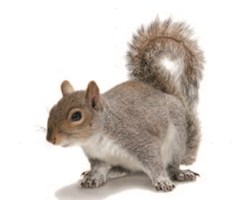 Eastern Gray:
Eastern Gray:
Length: 8-10 inches
Tail length: 7-10 inches
Weight: Just over a pound
Feet: Pink paw soles
As the name implies, the squirrel’s fur is predominately gray, but grizzled with red, black, and white hair. They are sometimes referred to as cat squirrels.
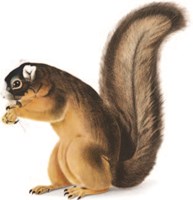 Fox:
Fox:
Length: 10-15 inches
Tail length: 9-14 inches
Weight: 1.5-2.5 pounds
Feet: Black paw soles
The Bachman or “Hill Country” fox squirrel inhabits more open, upland areas throughout the state. The fox squirrel’s body is a combination of black, brown, and orange body color, with a black mask and white colorations on the nose, ears, and paws. Each one typically exhibits slight variations in mask and white colorations on the nose, ears, and paws, so much so that some can be uniquely identified upon repeat observations. The Delta fox squirrel is limited to the Delta and fringes of this region. It has both a solid black and rusty red color phase, lacks a mask or white colorations, and is slightly smaller than the more upland subspecies.
Think like a squirrel
To successfully hunt squirrels, one must go where the squirrels are. Not surprisingly, a mature forest is the primary habitat component required for squirrels. Gray squirrels are generally more common in forests with some ground cover, such as low brush or fallen trees. They are likely to feel more secure with concealing cover when they have to take to the ground. In comparison, fox squirrels spend more active time on the ground than gray squirrels and select more open habitats with a higher degree of visibility. They will readily venture into open areas near forest cover. Fox squirrels are adapted to open forest conditions and areas where forests and fields are well interspersed. Although squirrels are dependent on forest habitats, they occupy residential areas, pecan and fruit orchards, agricultural fields, and other non-forest areas to take advantage of abundant food resources.
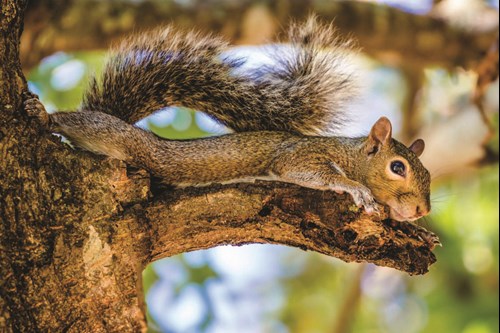
Eastern gray squirrel (photo by Jordan hill)
Both squirrel species eat a variety of plants, fungi, and animal foods. Squirrels eat nuts, seeds, and fruits (mast) from numerous trees. Oak, hickory, beech, pecan, and black walnut mast are highly desirable squirrel foods. Pine seed is also an important squirrel food, especially when acorns and other hardwood mast are scarce. Fruits of black and tupelo gums, dogwood, black cherry, wild plums, mulberry, and paw-paw are also highly desirable. Squirrels eat mushrooms and other fungi when available, as well as insects, grubs and other invertebrates, and eggs. Squirrels also feed on tender young leaves and buds in spring.
Larger tracts of mature hardwood and mixed pine-hardwood forests will typically support more gray squirrels than forests comprised predominately of pines. Longleaf pine forests can provide good habitat for the Bachman fox squirrel. Longleaf pine seed is an important food resource when available, and the fox squirrel is adept at manipulating the large, longleaf pine cones. Delta fox squirrels primarily use mature hardwood forests or woodlots in that region.
Hunting tactics
Squirrels are usually most active during the early morning and late afternoon, so these are generally the better times to hunt. Once squirrels are located, the hunter must apply some basic hunting skills as it relates to their quarry. For the novice hunter starting on his or her own, stalking (sometimes referred to as still hunting) is the basic squirrel hunting tactic. Hunters can simply hang around a good spot with plenty of squirrel activity and pick their shots as squirrels emerge. They can also actively stalk the woods for shots. Short of seeing a squirrel outright, a hunter can often hone in on a squirrel’s approximate location by being alert to its barking vocalizations, leaves rustling or limbs shaking, or the distinct sound of gnawing on an acorn or another nut.
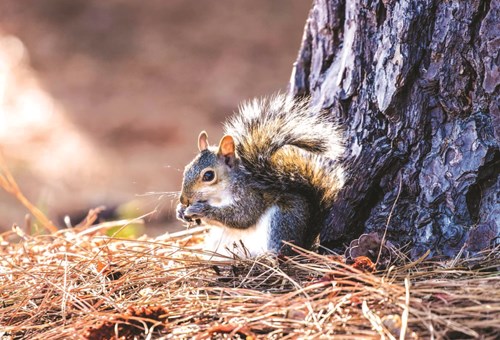
Eastern gray squirrel (photo by Jordan hill)
In stalking, the hunter moves slowly toward the squirrel, trying to keep some concealing cover (e.g., brush, trees) in between, for visual location and a clear shot. If the squirrel detects the hunter, it likely will hide or flee. When this happens, it can sometimes pay off to sit down and wait for a few minutes. The same squirrel or another might emerge for a shot after things settle down. Sometimes the squirrel wins. After all, that is why it is called hunting. These strolls in pursuit of squirrels can be quite rewarding regardless of the outcome. The hunter gets the opportunity to observe a variety of wildlife, practice woodsmanship, exercise, and just enjoy being outside.
Early in the hunting season, when trees are still full of leaves, finding clear shots at squirrels can be more difficult. With patience and experience, you will learn how squirrels behave and how to pick your shots. Later in the season, after most of the mast has fallen, squirrels will search more on the ground for food or visit stores of nuts they have previously buried or hidden away. Hunting tactics must be adapted as the season progresses. During the late season, hunters easily can spook squirrels on the ground, quickly sending them running to a tree to hide. A shot might be available while the squirrel is climbing, or if he stops momentarily to assess the potential intruder. Otherwise, it could pay off to wait quietly until squirrels reappear from their hiding places.
Squirrel hunting with dogs has seen a resurgence in popularity in recent decades. Squirrel hunting with treeing dogs is often more effective during the late season when more squirrels are feeding on the ground (allowing dogs more opportunity to detect their scent) and visibility has increased from leaf-fall. A squirrel-hunting dog can even become a good family pet. For the hunter with a newfound or rekindled passion for squirrel hunting, a dog can be a way to enhance the overall experience. However, realize that developing a squirrel hunting dog takes patience and an investment of time for training.
Legal harvest does not have negative impacts on squirrel populations. However, hunters are encouraged to harvest the Bachman fox squirrel conservatively in areas where this species is not regularly encountered. The availability of suitable forest cover and an abundance of natural foods are the primary factors that determine squirrel population productivity. Squirrel population abundance is sometimes low, usually in years following poor mast crops the previous fall and winter. Consequently, squirrel sightings and hunting success can be low during such years. However, squirrel populations will return to abundance when conditions are favorable. Squirrels have a high capacity to reproduce, and thus we can enjoy substantial opportunity to harvest this natural resource.
Small game, big benefits
For today’s fresh, local food-conscious set, squirrels are a healthy meal option when properly prepared. Keep harvested squirrels as cool as possible and remove entrails and skin within a few hours. As with any wild game, it is a good idea to carry disposable gloves and hand sanitizer if dressing squirrels in the field.
After washing dressed squirrels, they can be optionally soaked in lightly salted water several hours to overnight in the refrigerator before freezing or cooking. From a recipe standpoint, meat from squirrels can be readily substituted for chicken. Dishes such as chicken pie, chicken and dumplings, and chicken soup can be made by exchanging chicken for a cooked and deboned squirrel.
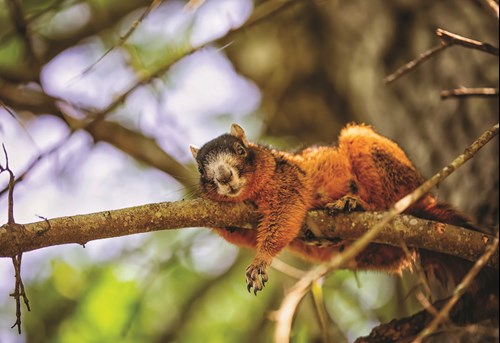
Bachman fox squirrel (photo by Jordan hill)
A squirrel can also be quartered into basic parts and breaded and fried. Some prefer to parboil or briefly pressure-cook squirrels before frying, especially in the case of older squirrels. The natural tenderness of squirrels can be estimated during skinning; the skin on young, tender individuals will pull free with much less effort and often require no parboiling for frying. A squirrel can also be used in stews, gumbo, and other variations the creative cook can devise. If you enjoy hunting squirrels, but do not like to eat them, find someone who can use the meat so it is not wasted. Always dress the game promptly and properly before giving it to others unless it is transferred within a few hours of harvest.
Because it does not require sitting still and quiet for long periods, squirrel hunting is a great way to introduce new hunters, especially young people, to hunting and the outdoors. In fact, on Saturday, Feb. 1, MDWFP will hold seven youth squirrel hunts throughout Mississippi. These hunts were developed to introduce youth (ages 10-15) to hunting and conservation. Perhaps most importantly, youth hunters learn basic woodsmanship skills for future outdoor endeavors. Squirrel hunting is an easy, low-cost, and exciting sport, and there are many public land hunting options around the state for hunters to get in on the action. For additional information on squirrels and hunting, visit mdwfp.com.
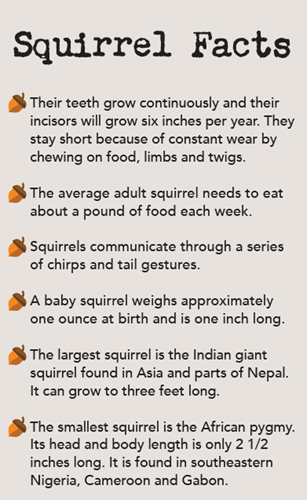
Rick Hamrick is MDWFP’s Small Game Program Leader.









